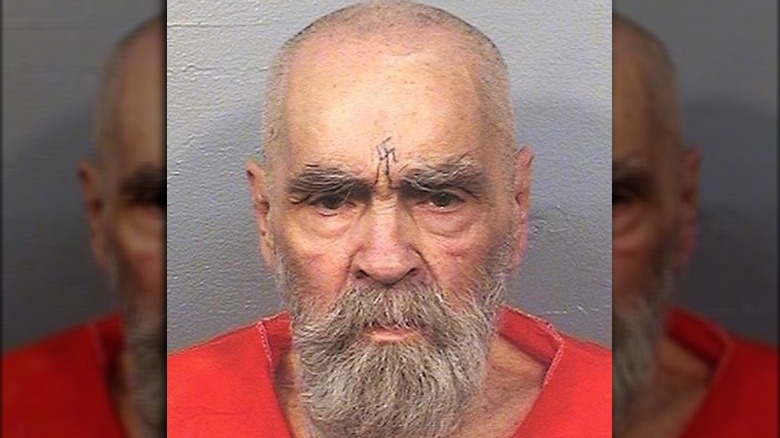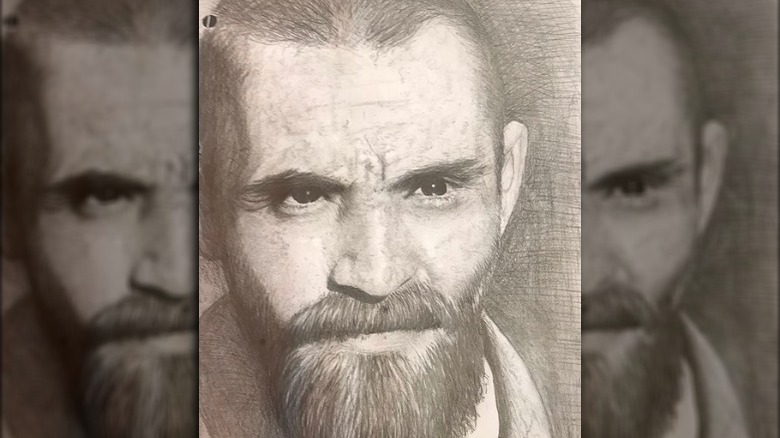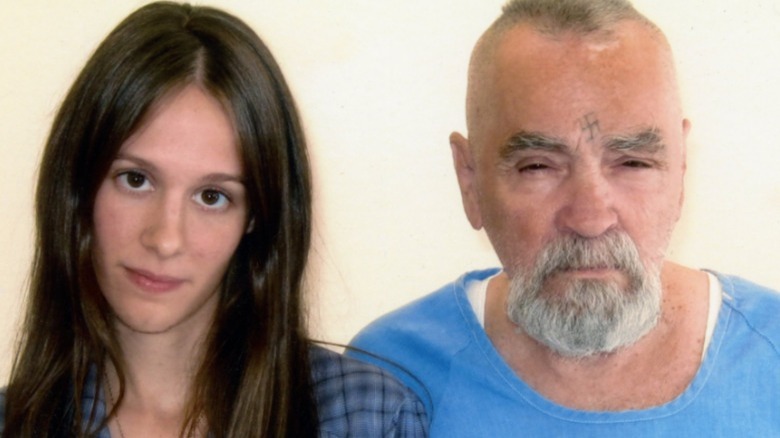What Charles Manson's Life In Prison Was Really Like
Charles Manson's behavior was as compelling as a train wreck. Even locked away in prison for nearly 50 years as the mastermind behind nine infamous brutal killings in the Los Angeles area in 1969, people just couldn't look away from the energetic man with piercing eyes.
Manson remained an enigma to the American public after the courts deemed him responsible for sending members of his "family" — or rather a group of young runaways and drifters who considered him their leader — into the homes of prominent people whom they violently murdered, leaving behind messages like "Political Piggy," "Death to Pigs," and "Healter Skelter" [sic] scrawled in the victims blood on the walls, per Insider.
The brutality of the murders and the fact that Manson had manipulated his young followers into committing such horrific acts as beating, shooting, and repeatedly stabbing nine people (including the 8-months-pregnant actress Sharon Tate), stunned the nation.
Manson was convicted of first-degree murder for his role in the Tate and LaBianca killings. Even though he was not physically present when they were murdered, the courts deemed him guilty of ordering the killings. Manson was sentenced to death in 1971, but shortly after the California Supreme Court deemed all death sentences prior to 1972 invalid, and his execution was commuted to life in prison, according to Biography.
Charles Manson was no model prisoner
By the time Charles Manson was sentenced to spend the rest of his life in prison at the age of 37, he was no stranger to incarceration. According to Rolling Stone, by the time he was released from prison in Washington five years prior after a seven-year stint for trafficking women for prostitution and forging checks, he'd already been in and out of reform schools and jails since his teen years.
Manson seemed to lack the ability to conform to any kind of societal laws, and the same could be said for prison rules. According to the Los Angeles Times, Manson never fully accepted blame for his actions. By 2017, the year he died, he'd been caught violating prison rules more than 100 times over the course of his life in prison. Those violations included things like threatening staff, spitting in guard's faces, throwing hot coffee at one staffer, assault, starting fights, possessing cell phones, and weapons (including a hacksaw he hid in his cell). He even tried to cause a flood and set his mattress on fire.
A representative for the California Department of Corrections and Rehabilitation told the Los Angeles Times, "Suffice it to say that he cannot be described as a model prisoner."
An inmate once set Charles Manson on fire
As one can imagine, Manson seemed to like to push people's buttons, to get in their heads. In 1984, one inmate retaliated when Manson threatened him. According to the Associated Press, Manson was giving convicted murderer, Jan Holstrom, the business over his Hare Krishna beliefs, so Holstrom doused Manson with paint thinner, which he had access to because the men were in the hobby shop of the prison. Holstrom then threw a match on Manson, causing third-degree burns on more than 18% of his body, mostly on his scalp, face, neck, and hands, per the AP.
No charges were filed against Holstrom. Prison authorities deemed the attack on Manson an act of self-defense since Manson had a record of assaulting other inmates.
At the time, the deputy district attorney of Solano County, James Highsmith, said, it would ″be a waste of time and effort to pursue the case any further,″ and it seemed ″unlikely that we could get a conviction,″ the AP reported.
Despite Manson's abrasiveness, he found new friends
Despite Charles Manson's knack for murder and mayhem, some people remained fascinated by him. During his nearly 50 years behind bars, Manson continually received lots of mail and visitor requests. Occasionally, he even developed relationships with some of the curious.
One such man was Ken Dickerson of Missouri, who maintained a pen pal/phone-call-type relationship with Manson from 2005 to 2012, per the Belleville News-Democrat (BND). The version of himself that Manson shared with Dickerson convinced him that Manson was more of an opportunist than a cult leader.
"Manipulation is kind of a weird way of thinking about something," Dickerson told BND. "I wasn't threatened by him. I think the cult thing is funny because I don't think there was a cult. I think there was just a bunch of runaway teens that needed a place to lay their heads. Charlie had good stories to tell; he took care of them and in return, they took care of him. You take care of one another."
Another relationship for Manson blossomed from letters when a man named Michael Channels started writing Manson. Eventually, the correspondence developed into in-person visits and a friendship after the men realized they had a lot in common, per The Signal. Manson ultimately sent Channels his will, leaving whatever he had to him, including his body. Manson's grandson, Jason Freeman, contested the will and won in 2018, according to NBC News.
Charles Manson was engaged while in prison
Another person who developed a relationship with Charlie Manson via letters was 16-years-old when she reached out to the convicted killer after discovering his philosophies the ATWA website, which stands for air, trees, water, animals, according to CNN. Afton "Star" Burton ended up moving from her parent's Illinois home to California to be able to visit Manson regularly at Corcoran State Prison after about three years of correspondence with him.
By the time she was 25 in 2013, she was still devoted to Manson and planned on marrying him, telling CNN, "I'm completely with him, and he's completely with me. It's what I was born for, you know. I don't know what else to say." Papers were filed for a marriage license, but the union never came to fruition.
According to Rolling Stone, the marriage license expired around the same time rumors and reports were swirling that Burton's real motivation for marrying Manson was so she would legally have access to his corpse when he died and could display it in a glass case where people could pay to come see it (per The New York Post). Per People, Manson told Rolling Stone he never had any intention of marrying Burton, saying, "Oh that. That's a bunch of garbage. You know that, man. That's trash. We're just playing that for public consumption."
Charles Manson
According to ABC News, Charles Manson had 12 parole hearings during his 46 years of incarceration for his role in the murder of nine people. Each time, he was denied. Sometimes, he didn't even show up to his parole hearings, but family members of his victims did. His final parole hearing was in 2012. Manson was not present, but at the hearing, a member of the panel read aloud some of what Manson had told a prison psychologist.
He said, "I'm special. I'm not like the average inmate. I have spent my life in prison. I have put five people in the grave. I am a very dangerous man."
In the end, Manson died an inmate of the California State Prison system at the age of 83 in November of 2017. According to TMZ, who obtained his death certificate, Manson's cause of death was cardiac arrest but colon cancer and respiratory failure were the underlying causes.





